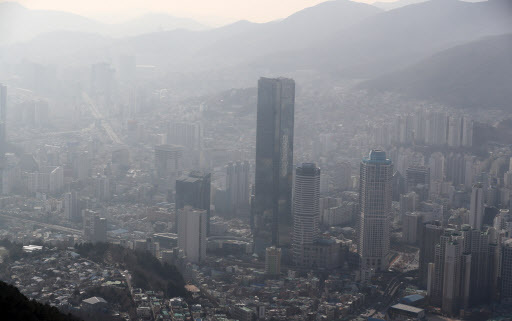Emergency measures enforced in S. Korea to fight fine dust
By Ock Hyun-juPublished : Jan. 14, 2019 - 15:34
Most of the country suffered high levels of fine particulate pollution Monday, prompting the Ministry of Environment and several local authorities to enforce emergency measures for the third consecutive day.
Seoul’s daily average level of ultrafine dust, or PM2.5, stood at 155 micrograms per cubic meter as of 5 p.m. on Monday, according to Air Korea. The average ultrafine dust level reached 120 micrograms in the nation’s capital, nearly five times the World Health Organization’s recommended daily average of 25 micrograms.
Seoul’s daily average level of ultrafine dust, or PM2.5, stood at 155 micrograms per cubic meter as of 5 p.m. on Monday, according to Air Korea. The average ultrafine dust level reached 120 micrograms in the nation’s capital, nearly five times the World Health Organization’s recommended daily average of 25 micrograms.

The ultrafine dust level was measured at 116 micrograms per cubic meter for Gyeonggi Province, followed by 111 for North Chungcheong Province, 102 for South Chungcheong Province and 100 for Incheon on Monday afternoon.
The emergency measures will remain in place on Tuesday as well in Seoul and nearby areas, according to Seoul Metropolitan Government.
Emergency measures aimed at tackling the toxic particles went into effect on Monday in 10 cities and provinces, including Seoul, Busan, Daejeon, Sejong, Gwangju and North and South Chungcheong provinces.
When emergency measures go into effect, thermal power plants in the areas must reduce their output to 80 percent of normal operations. Old diesel vehicles 2.5 tons or larger were banned from driving in the city. Some 430 parking lots at state-run organizations were also shut down. Some 100 public emissions facilities were required to keep operational hours shorter. Half of public officials’ vehicles were prohibited from roads.
The Seoul city government also closed its open-air ice skating rink in front of City Hall.
The government on Sunday and Monday sent out emergency alert text messages to warn about the high dust levels and to ask pedestrians to wear masks and refrain from outdoor activities.
It marked the third time, following instances in January and March last year, for the emergency measures to come into force for two consecutive days.
Most parts of South Korea began to experience unhealthy fine dust particles since Friday. Over the weekend, the fine dust level hovered around 89 to 107 micrograms, and the ultrafine dust level remained between 63 and 73 in central Seoul, forcing people indoors.
The particles are hazardous to human health. They are less than 2.5 micrometers in diameter -- about 30 times smaller than the width of a human hair. The particles can travel through the respiratory system and into the bloodstream, causing damage to human organs such as the heart and lungs.
Air Korea said that the density of PM2.5 in all areas was forcecast to be high because fine dust particles had accumulated in and out of the country due to a lack of wind, and additional dust particles had come from overseas.
The nationwide levels of fine dust will remain high throughout the country until the cold winds from the north bring down the temperature and clear the fine dust Tuesday, according to the Korea Meteorological Administration.
Questions continue to linger over the effectiveness of the government’s emergency measures that focus on tackling the fine dust particles produced domestically.
South Koreans largely perceive a huge portion of fine dust to originate from industrial areas in China, but there is yet a scientific research that could measure how much China contributes to the air pollution here.
Seoul Mayor Park Won-soon recently countered Beijing’s claims that China has nothing to do with the fine dust over the Korean Peninsula, citing research that suggest around 50 to 60 percent of fine dust over South Korea originates from China.
A spokesperson for the Chinese Ministry of Ecology and Environment, Liu Youbin, said in December that the air quality in China had improved over the years through regulatory measures, while that of Korea has worsened in the same period.
(laeticia.ock@heraldcorp.com)
-
Articles by Ock Hyun-ju








![[KH Explains] How should Korea adjust its trade defenses against Chinese EVs?](http://res.heraldm.com/phpwas/restmb_idxmake.php?idx=644&simg=/content/image/2024/04/15/20240415050562_0.jpg&u=20240415144419)











![[Today’s K-pop] Stray Kids to return soon: report](http://res.heraldm.com/phpwas/restmb_idxmake.php?idx=642&simg=/content/image/2024/04/16/20240416050713_0.jpg&u=)